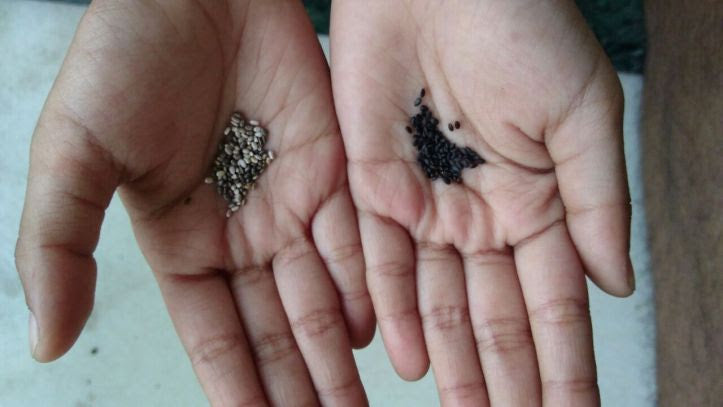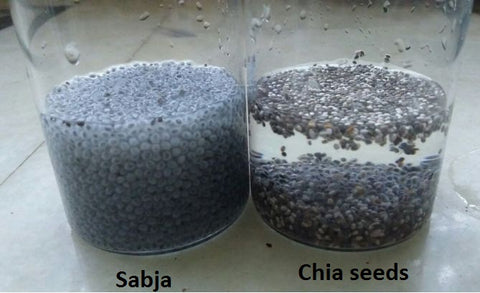
7 Differences between Chia Seeds & Sabja Seeds
Naturally YoursShare

Chia seeds are tiny power packed seeds that have been documented to be around since 3500bc in the diets of Aztecs and Mayans.
They had identified that these super seeds had the ability to increase stamina and energy over long periods of time
What Is The Difference between chia seed and sabja seeds (basil seeds)?
Chia seed is a native of Mexico and it does not have an Indian name. However it has time and again been confused with basil seeds which is also know as sabja in hindi. Be it in appearance, origin or health benefits; chia seeds are different from sabja in numerous ways.
Both chia seeds and sabja seeds originate from the mint family and hence the resemblance.
So how do you differentiate one from the other. Below are a few simple ways that can help you do so:
1.NATIVE
Chia seeds are native to central and southern Mexica.
While Sabja Seeds are native to India and the Mediterranean region.
2. COLOR


As can be seed in the above image the left side is CHIA SEEDS. They are usually a mixture of grey, black, white and sometimes even brown seeds. However even the black ones are not pitch black in colour. Instead a dull pattern or a mosaic is visible on them.
While on the right side SABJA SEEDS, are uniformly jet Black or pitch black in colour.
3. APPEARANCE

Chia seeds are oval in shape.
While Sabja seeds are elliptical, like tiny grains of rice
4. ON SOAKING IN WATER

Chia seeds takes time to absorb water. It has the unique ability to gel by absorbing over 10 times their weight
Sabja seeds swell up within seconds of being mixed with water. A translucent coat forms around the seed and it appears much larger in size when compared to a soaked chia seed
5. TASTE OF SOAKED SEEDS

Sabja seeds in water on the top glass, Chia seeds in water on the bottom glass
Chia seeds does not have any taste of its own and can easily be incorporated in any kind of dish.
Sabja seeds have a mild flavour of basil and imparts the same to drinks and desserts.
6. USAGE
Chia seeds can be consumed raw or soaked.
Sabja seeds can be consumed only after soaking
7. HEALTH BENEFITS
Both chia seeds and sabja have their own set of health benefits. They have been known to aid in weight loss due to their ability to make you feel fuller faster. Here are the most beneficial properties of the seeds:
Chia seeds
- Good source of proteins and Omega 3s
- The naturally low-carb and high-fiber food helps in digestion
- Highly recommended for weight-loss
- Promotes energy and endurance
- Helps in stabililizing blood sugar levels
Sabja Seeds
- One of the best body coolant
- Has a soothing effect on the stomach and hence useful to combat acidity
- Good source of vitamins and Iron
- Helps to promote healthy skin and hair
- Acts as a detoxifying agents and helps to cleanse the blood
FACTOR |
CHIA SEEDS |
SABJA SEEDS |
| Native | Native to Central and southern mexico | Native to India and the Mediterranean region |
| Colour | Usually a mixture of grey, black, white and sometimes even brown seeds. However even the black ones are not pitch black in colour. Instead a dull pattern or a mosaic is visible on them | Uniformly jet Black or pitch black in colour |
| Appearance | Oval in shape | Elliptical, like tiny grains of rice |
| On soaking in water | Chia takes time to absorb water. It has the unique ability to gel by absorbing over 10 times their weight. | Sabja swell up within seconds of being mixed with water. A translucent coat forms around the seed and it appears much larger in size when compared to a soaked chia seed |
| Taste of soaked seeds | Does not have any taste of its own and can easily be incorporated in any kind of dish. | Has a mild flavour of basil and imparts the same to drinks and desserts |
| Usage/Health Benefits |
Can be consumed raw or soaked.
Good source of proteins and Omega 3s |
Can be consumed only after soaking.
Has a soothing effect on the stomach and hence useful to combat acidity. |
Hope you liked this article. If you would like to add more differences do mention the same in the comments section below.
Trending Articles
1) Home remedies and diet tips for acne - Read Now
2) Myths and Facts about your digestive system - Read Now
3) 10 Evidence Based Weight Loss Tips - Read Now
ABOUT THE AUTHOR

With over 7 years of experience in the organic industry, Priya is a strong believer in using healthy and easy to use alternatives in daily life. She passionately advises her friends, family and customers by sharing with them practical and easy ways to include healthy alternatives in their daily life.

2 comments
Good information was shared. I am a health weight loss and lifestyle coach with over 51000 plus followers on Linkedin. I had a thorough check over your products and found them really genuine.I have ordered all the stuff and am trying them,the noodles variety sure are amazing.
Very good message